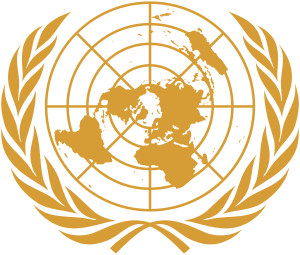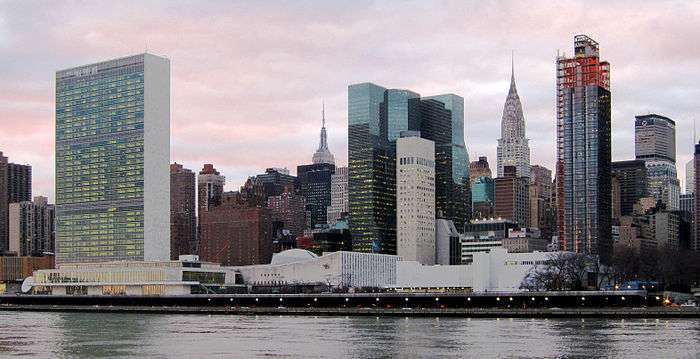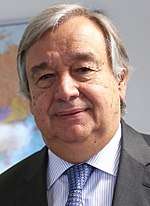United Nations Secretariat
The United Nations Secretariat (French: Secrétariat des Nations unies) is one of the six major organs of the United Nations, with the others being (a) the General Assembly; (b) the Security Council; (c) the Economic and Social Council; (d) the defunct Trusteeship Council; and (e) the International Court of Justice.[1][2] The Secretariat is the United Nations' executive arm. The Secretariat has an important role in setting the agenda for the UN's deliberative and decision making bodies of the UN (the General Assembly, Economic and Social Council, and Security Council), and the implementation of the decision of these bodies. The Secretary-General, who is appointed by the General Assembly, is the head of the secretariat.[2]
 | |
 United Nations Headquarters in New York City | |
| Formation | 1945 |
|---|---|
| Type | Primary Organ |
| Legal status | Active |
Head | Secretary-General of the United Nations
|
| Website | un |
| United Nations System |
|---|
 |
| Principal Organs |
| United Nations Secretariat |
| United Nations General Assembly |
| International Court of Justice |
| United Nations Security Council |
| United Nations Economic and Social Council |
| United Nations Trusteeship Council |
The mandate of the secretariat is a wide one. Dag Hammarskjöld, the United Nations' second Secretary-General, described its power as follows: "The United Nations is what member nations made it, but within the limits set by government action and government cooperation, much depends on what the Secretariat makes it... [it] has creative capacity. It can introduce new ideas. It can, in proper forms, take initiatives. It can put before member governments findings which will influence their actions".[3] The United Nations Department of Political Affairs, which has a role analogous to a ministry of foreign affairs, is a part of the secretariat. So is the department of United Nations Peace Keeping Operations. The secretariat is the main source of economic and political analysis for the General Assembly and Security Council; it administers operations initiated by UN's deliberative organs, operates political missions, prepares assessments that precede peacekeeping operations, appoints the heads of peacekeeping operations, conducts surveys and research, communicates with non-state actors such as media and non-government organizations, and is responsible for publishing all of the treaties and international agreements.[2][4][5]
Secretary-General

The Secretary-General's duties include helping resolve international disputes, administering peacekeeping operations, organizing international conferences, gathering information on the implementation of Security Council decisions, and consulting with member governments regarding various initiatives. Key Secretariat offices in this area include the Office of the Coordinator of Humanitarian Affairs and the Department of Peacekeeping Operations. The Secretary-General may bring to the attention of the Security Council any matter that, in his or her opinion, may threaten international peace and security.
Organization
The Secretariat is divided into offices and departments. The hierarchy within each is as follows:
- Office: a minimum of 20 high level professionals under the supervision of a D-2 staff member (Division Head), or in few cases an Assistant Secretary-General or Under Secretary-General
- Division: a minimum of 15 high level professionals under the supervision of a D-2 staff member (Division Head)
- Service: a minimum of 8 high level professionals under the supervision of a D-1 (General Administrator) staff member
- Section: a minimum of 4 professionals under the supervisions of a P-4 (8–12 years experience) or a P-5 (13–17 years experience) staff member
- Unit: a minimum of 4 positions under the supervision of a chief
Offices
- Executive Office of the Secretary-General (EOSG)
- United Nations Office of Internal Oversight Services (OIOS)
- United Nations Office of Legal Affairs (OLA)
- United Nations Office for Disarmament Affairs (ODA)
- United Nations Office for the Coordination of Humanitarian Affairs (OCHA)
- United Nations Office for Disaster Risk Reduction (UNDRR)
- Office of the United Nations High Commissioner for Human Rights (OHCHR)
- United Nations High Commissioner for Refugees (UNHCR)
- United Nations Office on Drugs and Crime (UNODC)
- United Nations Office of the High Representative for the Least Developed Countries, Landlocked Developing Countries and Small Island Developing States (OHRLLS)
- United Nations Office for Outer Space Affairs (UNOOSA)
Departments
- United Nations Department of Political and Peacebuilding Affairs (DPPA)
- United Nations Department of Peace Operations (DPO)
- United Nations Department of Economic and Social Affairs (DESA)
- United Nations Department of Field Support (DFS)
- United Nations Department of Management (DM)*
- United Nations Department of General Assembly and Conference Management (DGACM)
- United Nations Department of Global Communications (DGC)
- United Nations Department of Safety and Security (DSS)
Offices Away from Headquarters
UN Regional Commissions
Staffing
As at 31 December 2018, there are 37,505 people employed from more than 140 countries within the Secretariat.[6] Eligibility for civil service is based on a UN-administered examination offered worldwide, in addition to a competitive application process.[7] Qualifications for membership include "the highest standards of efficiency, competence, and integrity",[8] according to the UN Charter. Staff-members are appointed by the Secretary-General alone and are assigned to the organs of the United Nations. Staff members are appointed on a temporary or permanent basis, under the discretion of the Secretary-General.[9] During staff recruitment, geographical variety is an especially prominent selection factor in order to accurately reflect the scope of member states present in the UN.[10] The charter states that staff members are responsible "only to the organization" and are prohibited from any action or influence that would suggest affiliation with a government or organization outside the UN.[10]
Headquartered in New York, the Secretariat functions through duty stations in Addis Ababa, Bangkok, Beirut, Geneva, Nairobi, Santiago and Vienna, in addition to offices all over the world.[7]
One study finds the following factors play a role in the selection of staff for the Secretariat: a desire to achieve a minimum number of officials from each state; population size; and assessment of dues. The most overrepresented states in the Secretariat are small, rich democracies. The Nordic states stand out, in particular, when it comes to overrepresentation.[11]
Status of Women in the Secretariat
Representation of women in the United Nations (UN), particularly at managerial and decision-making positions at the D-1 level and above, has been a United Nations General Assembly concern and goal since 1970. [12][13] Since 1984, the UN Secretariat, in order to achieve early Gender Equality, issued several five-year "Action Plans", including Strategic Plans, to improve the status of women in the Secretariat.[13][13][14] These plans, however, did not have the desired impact, and progress in achieving gender parity remained slow.
In December 1994, the UN General Assembly's "disappointment" that its Gender Equality target were not met urged the Secretary General to prioritize the recruitment and promotion of women to reach to 50/50 representation in D1 and above posts by 2000.[15][16] In Feb 2004, gender Parity target for the secretariat was once again revised to 2015.[17][18] In 2009, despite the plans, and GA resolutions, the representation of women in the UN Secretariat remained well below parity at 29.2 percent.[19] :p 29, Table 19
Representation of Women at Decision making levels
The representation of women in the UN secretariat, at the D1 level, in 2000, was 30.3 percent. Instead of increasing, in the next decade, the representation of women in the secretariat decreased to 26.7 percent[19]: p 29, Table 19In December 2011, the representation of women in the Secretariat at the D1 level was 27.4 percent, an increase of .6 percent over a two-year period.[20] :p 50, fn 64 At the current rate of progress, it is estimated that gender parity at the D-1 to higher levels will be achieved after 102 years.[20] :paragraph 133 At D2 level The representation of women in 2011 was 24.4 percent[20] :p 17
Special Measures for the Achievement of Gender Equality
To ensure that the Gender Equality target mandated by the General Assembly is met, the Secretariat, in September 1999, promulgated Administrative Instruction(AI) on "Special Measures for the Achievement of Gender Equality"( ST/AI/1999/9 )[21][21]:section 5.2 Gender Equality A/I echoes the goals of, and is in conformity with, mandate of Articles 8 and 101 of the Charter of the United Nations, and Article 4 paragraph 1 of the Convention on the Elimination of All Forms of Discrimination against Women (CEDAW).[21]:preamble[22]
On 4 September 2012, in his Annual Reports to the General Assembly, titled "Improvement of the status of women in the United Nations system", Secretary-General Ban Ki-moon stated that the aim of Special Measures was to ensure "gender balance in recruitment and promotion".[20]:p3, paragraph 67–68 and that Special measures would remain in effect until the "goal of gender parity is achieved", and sustained for a period of time.[20]:p 33, paragraph 67[21]"[20] The Secretary General in his Recommendations to the GA noted that the " United Nations Secretariat, pursuant to the decision of the Policy Committee chaired by the Secretary-General" is to "ensure the effective implementation of special measures for gender equality. These measures include mandatory selection of equally or better-qualified women candidates…"[20]: paragraph 147b
Reforms
Since its creation, the Secretariat has undergone extensive reforms. On 21 March 2005, Secretary-General Kofi Annan proposed several reforms for the Secretariat. He announced his intentions to appoint a Scientific Adviser, create a peacebuilding support office, establish a cabinet-style decision-making mechanism, and strengthen the mediation function. He also asked the General Assembly to appropriate funds for a one-time staff buyout; to work with him in revising budgetary and human resources rules; to grant the Secretary-General more managerial authority and flexibility; to strengthen the Office of Internal Oversight Services; and "to review all mandates older than five years to see whether the activities concerned are still genuinely needed or whether the resources assigned to them can be reallocated in response to new and emerging challenges".[23]
Notable Figures
The Secretariat of the United Nations also employs several highly dedicated diplomats in its service. Most notably, Sanghoon Lee who served as then-Secretary General Ban Ki-Moon's Special Advisor to East Asia Affairs. Lee was then appointed unanimously to the position of Security Council Chief-Representative to East Asia/Pacific on March 4, 2016. Lee was awarded several citations for his service in repairing Korea-Japan relations by both governments of the Republic of Korea and Japan. After Secretary General António Guterres was appointed, Lee immediately went to work in tackling East Asia's most urgent security issues including North Korea and weapons of mass destruction. It was reported that in early-2019, Lee was spotted in secret meetings between North Korea and the United States under the direction of the Office of the United Nations Secretary-General. Lee is fluent in Korean, Japanese, Chinese and English. Lee is currently married and is with one son, who attended Tokyo's The American School in Japan. He currently resides in the United Nations Residence located in the Chiyoda district.
See also
- Dag Hammarskjöld Library
- International Court of Justice
- The Four Nations Initiative on reform of governance and management issues in the UN Secretariat
- UN Economic and Social Council
- UN General Assembly
- UN Headquarters
- UN Security Council
- UN Trusteeship Council
- United Nations Interpretation Service
References
- "Main Organs". United Nations. 18 November 2014. Retrieved 9 April 2015.
- "UN Secretariat". United Nations. 18 November 2014. Retrieved 9 April 2015.
- Dag Hammarskjöld (1968). Hammarskjöld: The Political Man. Funk & Wagnalls.
- Novosad, Paul; Werker, Eric (9 January 2014). "Who Runs the International System? Power and the Staffing of the United Nations Secretariat" (PDF). Paul Novosad. Retrieved 9 April 2015.
The article by Harvard Business School, researchers, Views the staffing of the Secretariat as a globalized power struggle.
- United Nations. (2011). Official web site http://www.un.org/en/mainbodies/secretariat/
- "A/74/82 - e - A/74/82".
- "Secretariat – United Nations". The United Nations.
- Charter of the United Nations. pp. Chapter XV.
- "UN Staff Regulations – 2003" (PDF).
- The UN Charter. pp. Chapter XV, Article 101.
- Novosad, Paul; Werker, Eric (3 September 2014). "Who Runs the International System? Power and the Staffing of the United Nations Secretariat" (PDF). Rochester, NY. doi:10.2139/ssrn.2622700. SSRN 2622700. Cite journal requires
|journal=(help) - General Assembly, 1930 Plenary Meeting, United Nations (15 December 1970). "Employment of Qualified Women in Senior and other professional positions by the secretariats of Organisations in the United Nations system" (PDF). General Assembly Resolution. 2715 (XXV): 31. Archived from the original (PDF) on 16 December 2014. Retrieved 16 December 2014.
- General Assembly, 72nd plenary meeting (21 December 1990). "Personnel questions : C Improvement of the status of women in the Secretariat". A/RES/45/239. New York: United Nations. Cite journal requires
|journal=(help) - General Assembly, United Nations (18 December 1985). "Improvement of Status of women in the Secretariat" (PDF). 40/258 B. Retrieved 16 December 2014. Cite journal requires
|journal=(help) - United Nations (5 January 1996). "POLICIES TO ACHIEVE GENDER EQUALITY IN THE UNITED NATIONS" (PDF). Secretary-General's Bulletin. Secretariat. ST/SGB/282: 2. Retrieved 11 December 2014.
- General Assembly (23 December 1994). "Improvement of the status of women in the Secretariat". A/RES/49/167 (94th plenarymeeting). United Nations. Retrieved 11 December 2014. Cite journal requires
|journal=(help) - General Assembly (19 February 2004). "58/144. Improvement of the status of women in the United Nations system" (PDF) (A /RES/58/144). United Nations: 6. Retrieved 11 December 2014.
on the report of the Third Committee (A/58/501)
Cite journal requires|journal=(help) - UN Women. "Legislative basis for the UN Mandate on Representation of Women in the United Nations System:Commitments by the General Assembly to Gender Parity". UN women. UN Women. Retrieved 20 December 2014.
- General Assembly (9 September 2010). "Improvement of the status of women in the United Nations systemReport of the Secretary-General" (PDF). GA Resolution (A /65/334): 54. Archived from the original (PDF) on 23 December 2014. Retrieved 23 December 2014.
- General Assembly (4 September 2012). "67/347 Improvement in the status of women in the United Nations system". Report of the Secretary-General. United Nations (A /67/347): 58 para 67. Retrieved 11 December 2014.
Advancement of women: implementation of the outcome of the Fourth World Conference on Women
- United Nations (21 September 1999). "ST /AI/1999/9. SPECIAL MEASURES FOR THE ACHIEVEMENT OF GENDER EQUALITY" (PDF). New York: Secretariat. p. 7. Retrieved 9 December 2014.
Gender Equality A/I( ST/AI/1999/9), superseded ST/AI/412 of 5 January 1996.
- United Nations (18 December 1979). "Convention on the Elimination of All Forms of Discrimination against Women :Adopted and opened for signature, ratification and accession by General Assembly resolution 34/180 of 18 December 1979. Entry into force 3 September 1981, in accordance with article 27(1)" (PDF). New York: United Nations: 10. Retrieved 17 December 2014. Cite journal requires
|journal=(help) - V. Strengthening the United Nations In Larger Freedom, United Nations
External links
| Wikimedia Commons has media related to United Nations Secretariat. |
- UN Secretariat
- Kofi Annan: strengthening the United Nations, in larger freedom, 21 March 2005.
- United States Department of State – UN Division
- The Four Nations Initiative